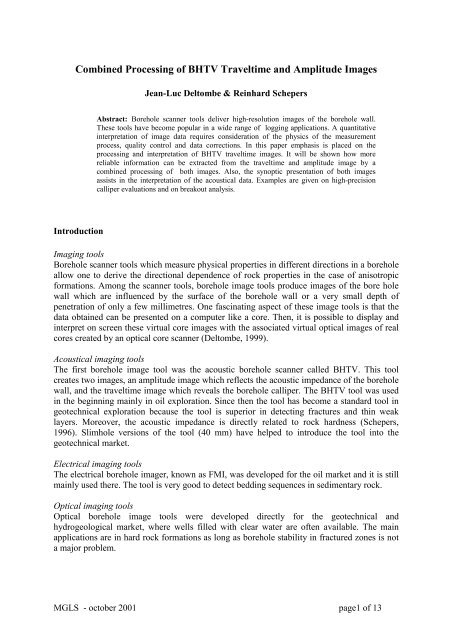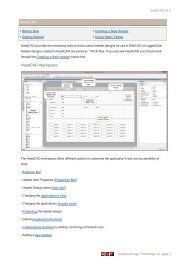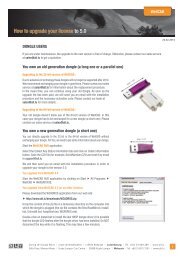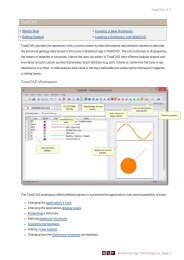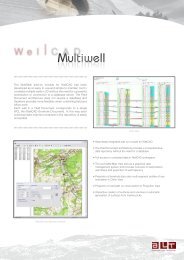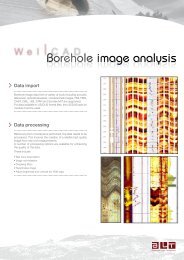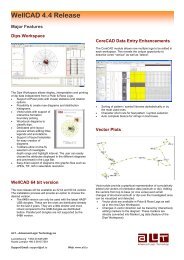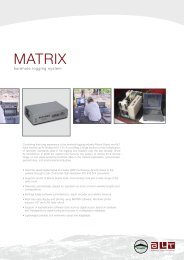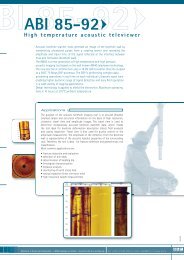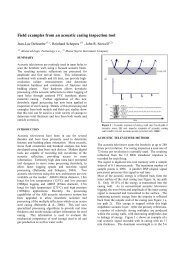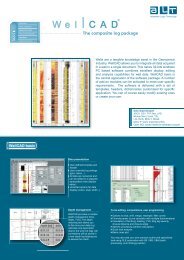Combined Processing of BHTV Traveltime and Amplitude Images
Combined Processing of BHTV Traveltime and Amplitude Images
Combined Processing of BHTV Traveltime and Amplitude Images
Create successful ePaper yourself
Turn your PDF publications into a flip-book with our unique Google optimized e-Paper software.
<strong>Combined</strong> <strong>Processing</strong> <strong>of</strong> <strong>BHTV</strong> <strong>Traveltime</strong> <strong>and</strong> <strong>Amplitude</strong> <strong>Images</strong><br />
Jean-Luc Deltombe & Reinhard Schepers<br />
Abstract: Borehole scanner tools deliver high-resolution images <strong>of</strong> the borehole wall.<br />
These tools have become popular in a wide range <strong>of</strong> logging applications. A quantitative<br />
interpretation <strong>of</strong> image data requires consideration <strong>of</strong> the physics <strong>of</strong> the measurement<br />
process, quality control <strong>and</strong> data corrections. In this paper emphasis is placed on the<br />
processing <strong>and</strong> interpretation <strong>of</strong> <strong>BHTV</strong> traveltime images. It will be shown how more<br />
reliable information can be extracted from the traveltime <strong>and</strong> amplitude image by a<br />
combined processing <strong>of</strong> both images. Also, the synoptic presentation <strong>of</strong> both images<br />
assists in the interpretation <strong>of</strong> the acoustical data. Examples are given on high-precision<br />
calliper evaluations <strong>and</strong> on breakout analysis.<br />
Introduction<br />
Imaging tools<br />
Borehole scanner tools which measure physical properties in different directions in a borehole<br />
allow one to derive the directional dependence <strong>of</strong> rock properties in the case <strong>of</strong> anisotropic<br />
formations. Among the scanner tools, borehole image tools produce images <strong>of</strong> the bore hole<br />
wall which are influenced by the surface <strong>of</strong> the borehole wall or a very small depth <strong>of</strong><br />
penetration <strong>of</strong> only a few millimetres. One fascinating aspect <strong>of</strong> these image tools is that the<br />
data obtained can be presented on a computer like a core. Then, it is possible to display <strong>and</strong><br />
interpret on screen these virtual core images with the associated virtual optical images <strong>of</strong> real<br />
cores created by an optical core scanner (Deltombe, 1999).<br />
Acoustical imaging tools<br />
The first borehole image tool was the acoustic borehole scanner called <strong>BHTV</strong>. This tool<br />
creates two images, an amplitude image which reflects the acoustic impedance <strong>of</strong> the borehole<br />
wall, <strong>and</strong> the traveltime image which reveals the borehole calliper. The <strong>BHTV</strong> tool was used<br />
in the beginning mainly in oil exploration. Since then the tool has become a st<strong>and</strong>ard tool in<br />
geotechnical exploration because the tool is superior in detecting fractures <strong>and</strong> thin weak<br />
layers. Moreover, the acoustic impedance is directly related to rock hardness (Schepers,<br />
1996). Slimhole versions <strong>of</strong> the tool (40 mm) have helped to introduce the tool into the<br />
geotechnical market.<br />
Electrical imaging tools<br />
The electrical borehole imager, known as FMI, was developed for the oil market <strong>and</strong> it is still<br />
mainly used there. The tool is very good to detect bedding sequences in sedimentary rock.<br />
Optical imaging tools<br />
Optical borehole image tools were developed directly for the geotechnical <strong>and</strong><br />
hydrogeological market, where wells filled with clear water are <strong>of</strong>ten available. The main<br />
applications are in hard rock formations as long as borehole stability in fractured zones is not<br />
a major problem.<br />
MGLS - october 2001 page1 <strong>of</strong> 13
Scope <strong>of</strong> paper<br />
Acoustic image tools measure simultaneously two different images, i.e. an amplitude log<br />
which is directly related to geotechnical rock properties, <strong>and</strong> a traveltime log which allows<br />
one to derive a very precise borehole calliper. Even though finally two different physical<br />
parameter are recorded the two image logs are related to each other. We want to point out in<br />
this paper which information can be extracted by a combined processing <strong>of</strong> the two acoustic<br />
images <strong>and</strong> their synoptic interpretation. But our emphasis is placed on the processing <strong>and</strong><br />
interpretation <strong>of</strong> traveltime image logs.<br />
Process <strong>of</strong> traveltime measurement<br />
Acoustical signal description<br />
W1<br />
W3<br />
Figure 1<br />
W2<br />
W4<br />
A typical signal send out <strong>and</strong> received by the acoustic transducer is schematically drawn in<br />
figure 1. The black line should be the signal which is recorded if there is no reflector. The first<br />
high amplitude wavelet is the transmitted signal followed by three coherent noise wavelets<br />
due to imperfect back damping or due to internal reflections inside the acoustic system. We<br />
assume that any incoherent electrical noise is always considerably smaller than any coherent<br />
acoustic noise. The level <strong>of</strong> such acoustic noise will limit a correct detection <strong>of</strong> traveltime in<br />
case <strong>of</strong> weak reflections from the borehole wall.<br />
Effect <strong>of</strong> noise<br />
The noise will, <strong>of</strong> course, depend on the acoustic components <strong>and</strong> the construction <strong>of</strong> the tool.<br />
But noise will also depend on the measurement window used during the recording <strong>of</strong> the<br />
image data. E.g. in figure 1 the window W1 is too close to the transmitted signal such that<br />
high amplitude values at the tail <strong>of</strong> the transmitted signal will result in a high noise level. A<br />
fixed long time window like W2 does not suffer from a potential wrong setting (W1) but it<br />
always includes the maximum coherent noise amplitude. The better approach is the individual<br />
optimal setting <strong>of</strong> the measurement window in accordance with the expected borehole calliper<br />
(W3 <strong>and</strong> W4). If the anticipated traveltimes fall into the gap between W3 <strong>and</strong> W4 <strong>and</strong> if<br />
reliable traveltime readings in areas <strong>of</strong> low reflection amplitudes are essential, an acoustic<br />
head with a different noise pattern can be used.<br />
MGLS - october 2001 page2 <strong>of</strong> 13
Detection process<br />
Once a measurement window is defined the next influence on the traveltime measurement is<br />
given by the detection process <strong>of</strong> signals reflected at the borehole wall. An assumed weak<br />
reflection is overlayed as a red wavelet on the noise signal <strong>of</strong> figure 1. If a simple trigger level<br />
detection is used the reflected signal will not be detected in windows W1 <strong>and</strong> W2, <strong>and</strong> it will<br />
be very unlikely that it is detected in W3. The red wavelet will be properly detected if a<br />
maximum detection process is used. Modern <strong>BHTV</strong> tools record the full wave form <strong>of</strong> the<br />
reflected acoustic signal. As transmission <strong>of</strong> the full signal to the surface is not possible due to<br />
the limited data capacity <strong>of</strong> st<strong>and</strong>ard logging cables, fast on-line processing is therefore<br />
applied to realise a more sophisticated reflection signal detection. Such processing can use<br />
knowledge about the noise pattern <strong>and</strong> expected traveltimes to optimise the detection. Even<br />
the variation <strong>of</strong> the noise pattern with depth can be taken into account. Practically, such<br />
processing further reduces the length <strong>of</strong> the measurement window <strong>and</strong> moves the position <strong>of</strong><br />
the window in an adaptive manner. In principle, this will allow one to detect the red wavelet<br />
in Windows W1, W2 <strong>and</strong> W3. But the situation depicted in figure 1 is fairly simple. The<br />
problem is more complex if the reflected signal is moving close to a noise signal. Finally<br />
constructive or destructive interference will change the signal form. If such a signal is<br />
detected at least the traveltime is close to the correct traveltime. On the other h<strong>and</strong> the<br />
amplitude is influenced considerably.<br />
Faulty detection<br />
Generally, we can state that in all cases where a wrong traveltime is detected, the amplitude is<br />
also wrong. On the other h<strong>and</strong>, the traveltime should be correct, if the amplitude is well above<br />
the noise level. As explained above the amplitude value can be wrong, even if the traveltime<br />
is correct. But this influence is only considerable at low amplitude values were relatively large<br />
amplitude variations can be assigned also to a number <strong>of</strong> other factors which are difficult to<br />
estimate properly.<br />
It is obvious that from the traveltime image an amplitude quality image can be derived which<br />
defines for each pixel, if the amplitude is reliable or if the amplitude is wrong. The procedure<br />
incorporates the definition <strong>of</strong> wrong traveltime reading so that in parallel a traveltime quality<br />
image is created. In addition, the amplitude image is used to further refine the traveltime<br />
quality image. But the traveltime quality image is still subjected to some ambiguity. Both<br />
quality images are used later during data processing <strong>and</strong> aid in a synoptic way in data<br />
interpretation procedures.<br />
Influence <strong>of</strong> directional resolution<br />
The performance <strong>and</strong> the usefulness <strong>of</strong> <strong>BHTV</strong> tools depend highly on their directional<br />
resolution. This resolution is defined by the width <strong>of</strong> the acoustic beam at the reflecting point,<br />
i.e. the borehole wall.<br />
Focused acoustical beam<br />
Figure 2 explains the principle features <strong>of</strong> a finely focused acoustic system. In the upper part<br />
<strong>of</strong> figure 2 the planar cross-section through the centre <strong>of</strong> a circular beam pattern is shown.<br />
Underneath the amplitude variation along the central axis <strong>of</strong> the beam is displayed. In the near<br />
field close to the transducer interference <strong>of</strong> acoustic energy results in rapid amplitude changes.<br />
From a certain distance on, the beam width <strong>and</strong> the amplitude stay more or less constant. The<br />
design goal for a good acoustic borehole system is to make the length (focal depth) <strong>of</strong><br />
constant width <strong>and</strong> amplitude as long as possible. Optimum resolution <strong>and</strong> quantitative<br />
exploitable results are achieved if the reflection interface (borehole wall) is within the focal<br />
MGLS - october 2001 page3 <strong>of</strong> 13
depth. The end distance <strong>of</strong> the focal depth depends on the frequency <strong>of</strong> the emitted signal <strong>and</strong><br />
the aperture <strong>of</strong> the acoustic system. After the end <strong>of</strong> the focal depth the beam is spreading out<br />
at an angle <strong>of</strong> about 5 0 <strong>and</strong> the amplitude is decreasing rapidly. Slim hole <strong>BHTV</strong> tools with a<br />
typical acoustic frequency <strong>of</strong> 1 MHz allow one to realise beam width <strong>of</strong> 3mm <strong>and</strong> to exp<strong>and</strong><br />
the focal depth to 100mm.<br />
acoustic<br />
transducer<br />
Beam width<br />
amplitude<br />
along<br />
beam axis<br />
distance from transducer<br />
actual<br />
beam<br />
pattern<br />
Figure 2<br />
The lower part <strong>of</strong> figure 2 shows an actual beam pattern gained from laboratory experiments.<br />
The constant beam width spreads out from 25mm to 75mm. The amplitude along the beam is<br />
indicated by colour variations.<br />
Spike in travel time image<br />
1<br />
2<br />
3<br />
Figure 3<br />
Such highly focused acoustic systems are in a<br />
positive sense very sensitive to borehole<br />
conditions. We have referred already to wrong<br />
traveltime readings. Often it is argued that a<br />
good <strong>BHTV</strong> tool should not produce spiky<br />
traveltime images. This is definitely wrong.<br />
The physics <strong>of</strong> acoustic wave propagation<br />
require that under certain borehole conditions<br />
only very weak reflection can be expected <strong>and</strong><br />
consequently no correct traveltime can be<br />
measured if the reflected amplitude is below<br />
the noise level. This means, the higher the<br />
dynamic range is <strong>of</strong> the acoustic system, the<br />
less spikes we get. But spikes cannot be<br />
avoided under all conditions. In figure 3, three<br />
situation are shown which will yield very weak<br />
or no reflections.<br />
MGLS - october 2001 page4 <strong>of</strong> 13
Case 1 is an open fracture where most <strong>of</strong> the energy is refracted into the rock <strong>and</strong> only a very<br />
small part is reflected back to the transducer.<br />
Case 2 is a steeply dipping interface. The total energy is reflected downwards without<br />
reaching the transducer.<br />
Case 3 represent a thin zone <strong>of</strong> very low impedance which could be a very s<strong>of</strong>t rock, a<br />
fracture or a mylonite zone. These zones are <strong>of</strong>ten accompanied by borehole washouts such<br />
that only some diffracting energy from the corner <strong>of</strong> the hard rock will reach the transducer.<br />
The better the resolution <strong>of</strong> a <strong>BHTV</strong> system, the more sensitive it is to not receive reflected<br />
energy in these cases described above. If a <strong>BHTV</strong> receives reflected signal in these cases the<br />
reflected energy can not come from the described structures. This means the real features are<br />
not correctly imaged.<br />
Comparison <strong>of</strong> good focused <strong>and</strong> bad focused system<br />
Figure 4 shall explain this with respect to a<br />
good focused <strong>and</strong> a bad focused system.<br />
1<br />
In case 1 the thin washed out zone is not<br />
detected by the unfocused system. In case 2<br />
the position <strong>of</strong> the edge <strong>and</strong> the transition<br />
2<br />
zone is not properly imaged by the<br />
unfocussed system. The same is true for<br />
case 3. In this last case we can expect the<br />
focused system to create one <strong>of</strong> those<br />
undesired spikes. But the spike tells us that<br />
3 the recorded amplitude is wrong <strong>and</strong> it<br />
gives a good estimate <strong>of</strong> the true position <strong>of</strong><br />
the edge. As will be discussed later<br />
focused / unfocused beam processing <strong>of</strong> the traveltime data can<br />
remove the spikes from the data <strong>and</strong> can<br />
shape <strong>of</strong> bore hole wall<br />
recorded traveltime<br />
processed traveltime<br />
True edge position<br />
help to reconstruct the true borehole shape.<br />
The blue line illustrates this.<br />
Figure 5 compares the traveltime images<br />
(TT) <strong>and</strong> the amplitude images <strong>of</strong> a highresolution<br />
<strong>BHTV</strong> tool (HR) with those <strong>of</strong> a<br />
low-resolution <strong>BHTV</strong> tool (LR). All<br />
Figure 4<br />
structural features are considerably clearer<br />
in the HR amplitude image. E.g. a thin<br />
fracture at 12.8m is only visible in the HR image. The black dots in the HR-TT traveltime<br />
image indicate wrong traveltime readings. With respect to the LR-TT image one can rather<br />
speak <strong>of</strong> black areas, because faulty traveltimes spread out all along each detected fracture.<br />
With reference to the discussions above this can only be explained by a low dynamic range <strong>of</strong><br />
the low-resolution system. The actually small calliper variations along the fractures are very<br />
well resolved by the HR-TT image.<br />
MGLS - october 2001 page5 <strong>of</strong> 13
Figure 5<br />
<strong>Traveltime</strong> corrections<br />
Correction for faulty detection<br />
In most cases the detection <strong>of</strong> wrong traveltimes is a fairly simple <strong>and</strong> unique process. This is<br />
due to the fact that the surface <strong>of</strong> the borehole wall is highly<br />
oversampled with respect to calliper variation as the<br />
sampling interval is defined by the desired high resolution<br />
<strong>of</strong> the amplitude image. Oversampling <strong>of</strong> the traveltime<br />
image makes a lot <strong>of</strong> sense with respect to detection <strong>of</strong> true<br />
edge positions <strong>and</strong> the definition <strong>of</strong> the amplitude quality<br />
image which is important for the quantitative interpretation<br />
<strong>of</strong> the amplitude image.<br />
In figure 6a, a borehole cross-section <strong>of</strong> a more or less<br />
Figure 6a<br />
circular borehole is drawn. The dark circular line gives the<br />
true shape <strong>of</strong> the borehole. Some <strong>of</strong> these typical spikes<br />
occur in the cross-section display <strong>of</strong> the measured traveltime data if e.g. a fracture along the<br />
borehole creates low reflection amplitudes. As can be explained by figure 1 the spikes can go<br />
to the inside (case W1) or to the outside (case W2). The length <strong>of</strong> the spikes depends on the<br />
actual calliper <strong>and</strong> on the measurement window settings. No sophisticated processing is<br />
necessary to detect wrong traveltime data in this very common case<br />
MGLS - october 2001 page6 <strong>of</strong> 13
The situation is more complicated if along a larger<br />
portion <strong>of</strong> the circumference there are many wrong<br />
readings <strong>and</strong> the true <strong>and</strong> wrong reading lie relatively<br />
close together such that a decision on wrong or right is<br />
difficult. The problem is illustrated by a cross-section<br />
display (figure 6b) as it is continuously monitored during<br />
field data acquisition. E.g. the traveltime readings in the<br />
upper right quadrant can be wrong but they may as well<br />
indicate a real breakout <strong>of</strong> the borehole wall. In this case<br />
a second run should be made where the traveltime quality<br />
image is refined by analysis <strong>of</strong> the amplitude image.<br />
Figure 6b<br />
Correction for decentralisation<br />
Detailed information about the borehole shape can be derived from the traveltime image. The<br />
<strong>BHTV</strong> tool does not really measure borehole calliper, rather it measures multiple distances<br />
from the tool to the borehole wall. Calliper is only defined with respect to the centre <strong>of</strong> a<br />
regular shaped borehole.<br />
Influence on travel time<br />
In figure 7 three different situation are schematically<br />
1<br />
presented. In case 1 the tool is decentralised in a circular<br />
borehole. The two green arrows indicate the two direction<br />
where the acoustic beam hits the borehole wall<br />
perpendicularly. Only at these two direction we get<br />
maximum reflection amplitudes <strong>and</strong> the addition <strong>of</strong> the two<br />
opposite traveltimes gives us the true borehole calliper. In<br />
2<br />
the direction <strong>of</strong> the two red arrows we measure a secant.<br />
The length <strong>of</strong> the secant depends on tool position. In case 3<br />
the tool is decentralised in an elliptical borehole. The<br />
borehole wall is hit perpendicularly in four directions. But it<br />
is quite obvious that the addition <strong>of</strong> the distance given by<br />
3<br />
the red arrows <strong>and</strong> distance in the opposite direction (green<br />
arrow) does not give a meaningful calliper value. Again, in<br />
case 2 the beam is perpendicular to the borehole wall in<br />
four directions. Calliper values can be calculated in all<br />
Figure 7<br />
directions, because the tool is in the centre <strong>of</strong> the borehole<br />
cross-section. In case <strong>of</strong> an irregular shaped borehole a<br />
“centre” is not uniquely defined. We will discuss later how the traveltime data can be used to<br />
define a centre in such a case.<br />
MGLS - october 2001 page7 <strong>of</strong> 13
Figure 8<br />
Influence on amplitude<br />
As explained above the measured traveltime image depends on the position <strong>of</strong> the <strong>BHTV</strong> tool<br />
in the borehole. Figure 8 shows a typical result <strong>of</strong> a <strong>BHTV</strong> measurement. The traveltime is<br />
displayed in the left image track. We see a clear maximum (yellow) <strong>and</strong> minimum (blue) in<br />
the traveltime image. The difference between maximum <strong>and</strong> minimum is changing <strong>and</strong> also<br />
the direction <strong>of</strong> maximum <strong>and</strong> minimum. It is very likely in this case that the tool is not<br />
running along the centre <strong>of</strong> a more or less circular borehole (case 1 <strong>of</strong> figure 7). The amount<br />
<strong>of</strong> decentralisation <strong>and</strong> its direction is changing with depth. The traveltime image <strong>of</strong> figure 8<br />
does not tell us much about the borehole shape besides that we may assume a relatively<br />
smooth borehole wall.<br />
The information about decentralisation has its value with respect to the amplitude image. The<br />
influence <strong>of</strong> decentralisation (see figure 7) on the amplitude image in the middle track <strong>of</strong><br />
figure 8 is visible as two broad shades (light brown) running parallel to the variation <strong>of</strong> the<br />
traveltime image. The narrow dark brown line in the amplitude image is due to tool<br />
construction. The shades <strong>and</strong> hence the influence <strong>of</strong> decentralisation can be removed to some<br />
extent from the amplitude image by a 2D high-pass filter. The result <strong>of</strong> the process is shown<br />
in the left track <strong>of</strong> figure 8. This image does not preserve the absolute variation <strong>of</strong> the<br />
amplitude values. Also, artefacts can be created in areas <strong>of</strong> rapid changes <strong>of</strong> the traveltime <strong>and</strong><br />
amplitude image. Therefore, a crosscheck with both original images is recommended.<br />
MGLS - october 2001 page8 <strong>of</strong> 13
Knowing the position <strong>of</strong> the tool we can add another information to the amplitude quality<br />
image. It marks the direction where the acoustic beam was perpendicular to the borehole wall.<br />
This information can be later used to derive a rock hardness log based on a reliable estimation<br />
<strong>of</strong> the reflection amplitude for each depth.<br />
Borehole shape calculation<br />
To come to the borehole shape, the first thing to do is to transfer the traveltime data into<br />
distance data relative to the centre <strong>of</strong> the borehole. Then, we can directly see the borehole<br />
shape if we display cross-sections <strong>of</strong> the distance data. Such an approach is not adequate if an<br />
overview over longer borehole intervals is required. Furthermore small details <strong>of</strong> borehole<br />
shape may not be visible as the display range <strong>of</strong> the traveltime data is governed by the amount<br />
<strong>of</strong> decentralisation.<br />
Figure 9<br />
Figure 9 shows some <strong>BHTV</strong> data with three different presentations <strong>of</strong> traveltime data. The<br />
first track on the left is a st<strong>and</strong>ard unrolled display <strong>of</strong> the traveltime image. According to the<br />
borehole cross-section in the third track the borehole is more or less circular. The track on the<br />
right shows a 3D displays where the distance image is use to create a perspective 3D view <strong>of</strong><br />
borehole geometry. The amplitude data <strong>of</strong> track two is projected onto the 3D body. You may<br />
think: what a crooked hole the drillers have made. But you are wrong. The hole is perfectly<br />
straight. The borehole geometry appears to be so crooked because the distances are calculated<br />
relative to the actual tool position which is not constant. There are some small scale feature<br />
visible along the borehole. But it is difficult to decide if they are real or not. This example<br />
MGLS - october 2001 page9 <strong>of</strong> 13
may point out how important it is to apply corrections to the distance image before a realistic<br />
3D display can be generated.<br />
We know the position <strong>of</strong> the tool relative to the borehole cross-section. This gives us the<br />
possibility to simulate in the computer the movement <strong>of</strong> the tool from its actual position to the<br />
centre <strong>of</strong> the borehole. The correction task is then to calculate the effect <strong>of</strong> such movement on<br />
each distance value. After the corrections are applied<br />
the distance image will look as if the tool has moved<br />
perfectly along the centre <strong>of</strong> the borehole. In the case <strong>of</strong><br />
a regular borehole it is easy to define a centre <strong>of</strong> the<br />
borehole. The problem <strong>of</strong> the correction procedure is to<br />
adapt a practical approach for the calculation <strong>of</strong> the<br />
borehole centre.<br />
Figure 10<br />
In figure 10 a vertical projection <strong>of</strong> an inclined <strong>and</strong><br />
irregular hole interval is indicated by two dark lines.<br />
Boreholes are drilled with a drill bit <strong>of</strong> a certain size <strong>and</strong><br />
with drill strings with some rigidity <strong>and</strong> hence a<br />
minimum radius <strong>of</strong> curvature. Therefore, we define the<br />
centre <strong>of</strong> the borehole as the central axis <strong>of</strong> a pipe with<br />
the diameter <strong>of</strong> the drill bit which is fitted into the<br />
borehole with maximum curvature. One possibility to<br />
calculate the path <strong>of</strong> the virtual pipe has been described<br />
by Menger <strong>and</strong> Schepers, 1988. In all such calculation<br />
algorithm the information <strong>of</strong> the traveltime quality<br />
image should be implemented. A result <strong>of</strong> a pipe fitting<br />
process is presented in figure 10 by red lines.<br />
<strong>Traveltime</strong> interpretation <strong>and</strong> presentation<br />
High resolution calliper<br />
The result <strong>of</strong> a high resolution <strong>BHTV</strong> survey is shown in figure 11.<br />
The amplitude image on the left side exhibits many thin fractures. The uncorrected traveltime<br />
image in the middle indicates that along some fracture material is broken out, e.g. along the<br />
steeply dipping fracture at 42m. The amplitude image <strong>and</strong> the traveltime image were used to<br />
create the 3D display on the right side. Many spikes are visible along the borehole. As<br />
explained above the appearance <strong>of</strong> spikes under special borehole conditions (like open<br />
fractures) can be considered as a pro<strong>of</strong> <strong>of</strong> the high resolution capability <strong>of</strong> the <strong>BHTV</strong> tool <strong>and</strong><br />
the spikes identify pixels where no true amplitude is measured. Of course, in the final display<br />
<strong>of</strong> traveltime data we would like to present the true borehole shape without spikes. Also, this<br />
will be necessary to see small calliper variations. Using the traveltime quality image<br />
prediction <strong>and</strong> interpolation algorithm can be applied to calculate the distance value at those<br />
pixels where spikes occur. In many cases a 2D low-pass filter can help to remove the spikes<br />
<strong>and</strong> to reconstruct the borehole shape. If the preservation <strong>of</strong> edges is <strong>of</strong> importance (e.g. in<br />
breakout analysis) 2D medium filter (Castleman, 1979) –or more general 2D percentage filtershould<br />
be applied.<br />
MGLS - october 2001 page10 <strong>of</strong> 13
Figure 11<br />
Presentation <strong>of</strong> very small (2 mm) bore hole caliper undulations induced by the drilling process<br />
Figure 12<br />
MGLS - october 2001 page11 <strong>of</strong> 13
The results in figure 12 are a good example how much details <strong>of</strong> the borehole shape can be<br />
made visible after correction <strong>of</strong> the distance image for tool decentralisation <strong>and</strong> after removal<br />
<strong>of</strong> the spikes. The calliper image – or more correctly the distance image – is shown on the left<br />
side <strong>of</strong> figure 12. The amount <strong>and</strong> the good resolution <strong>of</strong> the calliper variations can be derived<br />
from the four tracks on the right which display individual calliper logs at four directions. As<br />
the scaling is from 40mm to 60mm the variations are in the range <strong>of</strong> only 2mm. The shape <strong>of</strong><br />
the borehole is nicely revealed by the 3D display in figure 12. The scale is exp<strong>and</strong>ed such that<br />
the centre <strong>of</strong> the 3D display does not correspond to the centre <strong>of</strong> the borehole. Not the<br />
amplitude image but the calliper image is projected onto the borehole shape. The now clearly<br />
visible spiral along the borehole was created by the drilling process.<br />
Breakout analysis<br />
If the magnitude <strong>of</strong> maximum <strong>and</strong><br />
minimum horizontal stress differ<br />
considerably from each other the borehole<br />
is deformed. These deformations lead to<br />
stress concentration <strong>and</strong> breakouts <strong>of</strong> the<br />
borehole wall occur in those intervals<br />
where the stress exceeds the strength <strong>of</strong><br />
the rock (Barton, 1988). Typical for<br />
breakouts is that they develop on opposite<br />
sides <strong>of</strong> the borehole. The direction <strong>of</strong> the<br />
breakouts defines the direction <strong>of</strong><br />
minimum horizontal stress.<br />
A very exciting way <strong>of</strong> breakout<br />
presentation can be realised with 3D<br />
presentation s<strong>of</strong>tware which allows the<br />
user to move into all positions inside <strong>and</strong><br />
outside the borehole <strong>and</strong> to look in all<br />
directions. Figure 13 displays one<br />
snapshot <strong>of</strong> such a presentation <strong>of</strong> a<br />
borehole section with breakouts.<br />
The 3D nicely reveals that breakouts are<br />
also visible on the amplitude image. This<br />
is due to the fact that the stress<br />
concentration has lead to deterioration <strong>of</strong><br />
the rock. Acoustic measurement are very<br />
sensitive to detect defects in the rock. The<br />
blue colour (low amplitudes) in the<br />
amplitude image indicate these weak<br />
Figure 14<br />
zones which are wider than the breakouts<br />
itself. This means that some material is<br />
already partly destroyed but not yet broken out. Therefore, the amplitude image can be<br />
considered as an additional tool not only to see existing breakout but also to detect potential<br />
breakout areas. In the light <strong>of</strong> this new result the determination <strong>of</strong> the width <strong>of</strong> breakouts has<br />
to be carefully considered.<br />
MGLS - october 2001 page12 <strong>of</strong> 13
Conclusion<br />
The high information content <strong>of</strong> <strong>BHTV</strong> images can be used in a wide range <strong>of</strong> logging<br />
applications where quantitative data evaluation is required. But prior to any quantitative<br />
interpretation it is essential to apply quality control, corrections <strong>and</strong> processing <strong>of</strong> the image<br />
data. Additional information is gained by a combined processing <strong>of</strong> the <strong>BHTV</strong> traveltime <strong>and</strong><br />
amplitude images. Proper presentation <strong>and</strong> evaluation tools should assist the further<br />
interpretation process. New aspects <strong>of</strong> borehole breakout analysis could be revealed by<br />
adequate processing <strong>and</strong> presentation.<br />
References<br />
Barton, C.A., 1988. Development <strong>of</strong> In-situ Stress Measurement Techniques for Deep<br />
Drillholes, Dissertation, Stanford Rock & Borehole Project, 35, August 1988.<br />
Castleman, K.R., 1979. Digital Image <strong>Processing</strong>, Prentice Hall Inc., Englewood Cliffs, NJ.<br />
Deltombe, J.R., R. Schepers, <strong>and</strong> A. Toumani 1999. The practice <strong>of</strong> combined Core Image<br />
<strong>and</strong> Image Log interpretation for structural, lithological, sedimentological, <strong>and</strong> geotechnical<br />
applications. Proceedings <strong>of</strong> the International Symposium on Imaging Applications in<br />
Geology, University <strong>of</strong> Liège, Belgium.<br />
Menger, St. <strong>and</strong> R. Schepers, 1988. A Method to Derive High-Resolution Calliper Logs from<br />
Borehole Televiewer <strong>Traveltime</strong> Data, Proceedings <strong>of</strong> the 58 th Annual International SEG<br />
Meeting, p 554 – 556, Anaheim, CA.<br />
Schepers, R., 1996. Application <strong>of</strong> Borehole Logging to Geotechnical Exploration.<br />
Proceedings <strong>of</strong> the HANWHA Symposium, Seoul, Korea.<br />
MGLS - october 2001 page13 <strong>of</strong> 13


